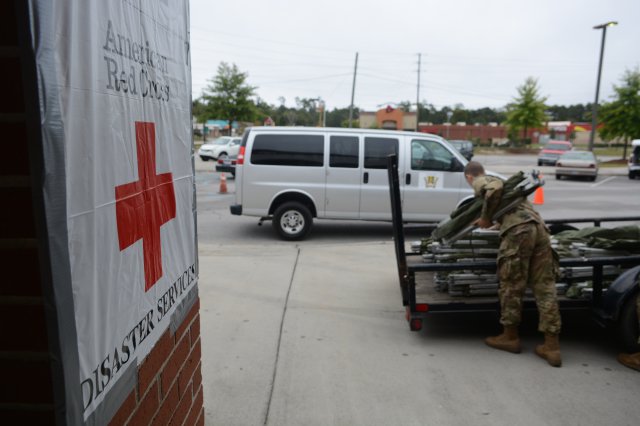Thursday, August 31st 2017 (WASHINGTON) All over the country, individuals are opening their wallets and hearts to give what they can to Hurricane Harvey relief efforts. But charity can be an incredibly complex business.
In recent days there have been damning news reports and social media posts telling people not to give money to some of the country’s most well-known charities and relief organizations.
http://wjla.com/news/nation-wo
Some donors who are skeptical of the larger groups have begun pouring money into GoFundMe accounts or Facebook sites. This had led to countless warnings from local chambers of commerce, the Better Business Bureau and charity watchdogs about relief scams from individuals and groups trying to profit from the disaster.
It is estimated that Hurricane Harvey could be the costliest natural disaster in U.S. history. Contributions have already begun flowing, but recovery is a long-term prospect.
It is only natural for people to want to help, but many are wondering how to make sure their money or contribution is used most effectively to provide relief to the victims of Hurricane Harvey.
WHY BIGGER CAN MEAN BETTER:
Daniel Borochoff is the president of Charity Watch, an independent watchdog group that rates the effectiveness of charities and nonprofits and exposes abuses by those same groups.
Borochoff was taken aback by reports in the media and social media criticizing groups like the Salvation Army and the American Red Cross, who are now bringing supplies, capacity and volunteers into storm-ravaged parts of Texas.
“These are the heavy-lifters. These are the main charities that have the resources to be able to mobilize massive amounts of help,” he said.
In the short-term, these and similarly well-resourced organizations can often have the biggest impact on emergency relief. But relief work comes in phases —rescue, emergency relief and recovery. Further down the road, different charities will need help providing different kinds of support to get people back on their feet.
Many of the transportation routes into the hardest hit parts of Texas remain blocked off or limited. In the context of the immediate emergency, those who have the best logistics can often make the most difference.
Individuals have gone out of their way to provide boats, clothing, and other supplies, which is very important. But in the face of an epic catastrophe, economy of scale is important and logistics are important. Which is why officials have put in place a network of high-capacity partners in the nonprofit and private sector.
THE ‘OFFICIAL’ LIST:
For the most immediate relief efforts, government agencies and charity-ranking organizations are urging individuals to give to work with the largest and most-trusted groups many of which are part of the Federal Emergency Management Agency’s (FEMA) interagency disaster response and recovery framework.
As Harvey touched down, FEMA urged individuals wanting to help hurricane victims to connect and contribute to nonprofits within the National Voluntary Organizations Active in Disaster (NVOAD).
The NVOAD and state VOADs represent a coalition of charity and relief groups that the government calls upon in the event of a state or federal disaster declaration. The Texas VOAD has 42 members.
This go-to network includes the big charities like the Salvation Army, Red Cross, Habitat for Humanity, Samaritan’s Purse, United Way along with hundreds of community, faith-based and other nonprofits. The coalition is diverse and includes partners who specialize in the various phases of disaster relief.
The network is in place in large part to better coordinate efforts with high-capacity donors in the private sector. Donors who can provide
For example, Bass Pro Shops joined efforts with Texas state and local government officials to help facilitate water rescue operations. Bass Pro donated 80 Tracker boats and 40,000 in supplies.
Since August 29, Anheuser-Busch, the nation’s largest beer distributor, has sent a total of five truckloads full of canned water to Red Cross facilities in the Gulf Coast. The Budweiser brewers did not send their Clydesdales, but relied on the Red Cross to distribute those 410,000 cans of water to those who are most in need.
Wal-Mart has sent water, blankets, cleaning supplies and other items to hurricane victims in the Gulf. The company posted an image of a fleet of 18-wheelers waiting to pick up water to transport to Texas.
Given the size of the emergency relief effort, now is not the time to undercut the efforts of the organizations that are able and willing to meet demand, Borochoff said. “These are the ones that are in place and prepared and have the background to be able to help.”
WHY SOME ARE SAYING ‘DON’T GIVE’:
On Wednesday, NPR got an interview with Red Cross vice president of disaster operations and logistics, Brad Kieserman to ask what percentage of donations had been spent on Harvey relief.
The story lit up social media with the headline, ‘Red Cross Exec Doesn’t Know What Portion Of Donations Go To Harvey Relief.’
As of Wednesday, Kieserman reported the Red Cross had spent $50 million on Harvey relief, primarily on 232 shelters for 66,000 people. He referred the reporter to the organization’s chief fundraiser to answer the question.
The confrontation is part of a series of reports NPR has done on the American Red Cross, starting with its response to the 2010 earthquake in Haiti where the Red Cross reportedly spent one-quarter of donations on “internal expenses.” The issue became the subject inquiry by the chairman of the Senate Judiciary Committee.
In 2014, NPR and ProPublica reported on internal memos documenting the mismanagement of the Hurricane Sandy response, charging the Red Cross was “so consumed with public relations that it hindered the charity’s ability to provide disaster relief.”
While the group has admitted to serious mistakes in handling Hurricane Sandy, a lot of the general criticism large charities get for spending donors’ dollars on overhead and administrative costs have been debunked.
In 2013, GuideStar, the Better Business Bureau’s Wise Giving Alliance and Charity Navigator wrote an open letter debunking that the value of a charity depended solely on a financial ratio.
In a letter to the donors of America, the group of nonprofit monitors wrote, “The percent of charity expenses that go to administrative and fundraising costs—commonly referred to as ‘overhead’—is a poor measure of a charity’s performance.”
While overhead can be an indicator of fraud or abuse, for example, CEOs of faith-based charities taking home six-figure salaries tax-free, the group said many charities should actually spend more on overhead.
“Overhead costs include important investments charities make to improve their work: investments in training, planning, evaluation, and internal systems—as well as their efforts to raise money so they can operate their programs.”
Having a disorganized organization, without trained volunteers or the logistics to carry out the charitable mission, directly impacts the effectiveness of any individual contribution.
“People don’t get that,” Borochoff emphasized. There is a lot of preparation, planning and oversight that goes into any effective project, as well as the people managing the effort, who take a salary so they can put food on the table and a roof over their heads.
SCAMS:
With so many people eager to help and a climate of big-charity skepticism, some individuals are turning to online platforms like GoFundMe or Facebook to make their donations.
Charity Watch, other nonprofit monitors and government agencies are advising generous donors to steer clear of these fundraising pitches, especially if they don’t know the person or group personally.
The Federal Trade Commission urged donors be cautious and do the research. “Don’t assume that charity messages posted on social media are legitimate.”
The Better Business Bureau warned donors of crowdfunding appeals and “storm-chasers” looking to make money off of the disaster. “Keep in mind that some crowdfunding sites do very little vetting of individuals who decide to post for assistance after a disaster,” the business oversight organization advised.
“If you decide to contribute via crowdfunding, it is probably best to give to people who you personally know that have posted requests for assistance.”
Borochoff advised that giving money to the most popular online personality may not be the best way to allocate charitable dollars. “What’s good about the charities is they have caseworkers who know how to ascertain the needs of individuals and what their alternative sources of money are.”
Moving forward, individuals are going to have access to insurance money, victims compensation, as well as city, state and federal funds.
“We don’t want to just give money to people on the internet that may already be taken care of or may not be in as much need as other people that aren’t getting the aid that they need to have,” he said.
As the conditions on the ground change, so will the needs of storm victims. Officials have said that for Houston and other parts of the Gulf Coast, recovery will take months and probably years. Charitable groups will have sustained needs throughout that long-term process.
In the meantime, there are many vetting tools to help generous individuals have the greatest impact.






